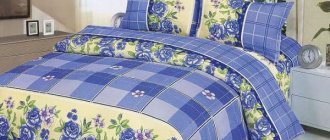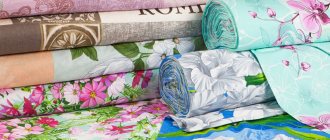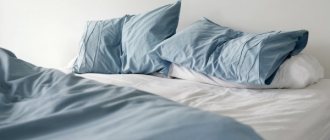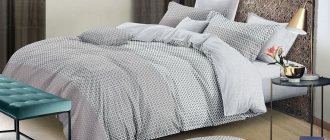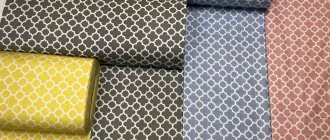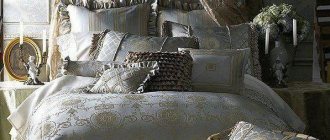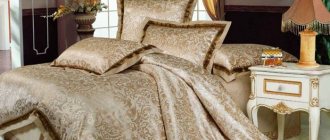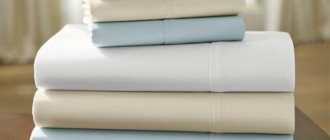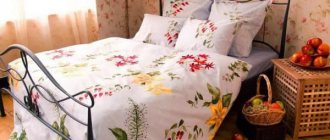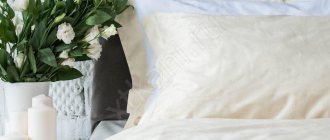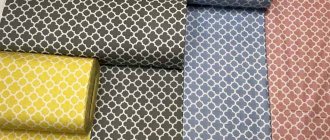Polysatin is a fabric that has the composition: 50% cotton and 50% polyester. Thanks to this composition, polysatin has good properties - it is durable, does not wrinkle, does not shrink after washing, does not wrinkle, dries quickly and is easy to iron. This fabric is very practical and will last you a long time!
The textile industry is developing at tremendous speed, which contributes to the emergence of new varieties of fabrics. Polysatin refers specifically to modern fabrics that appeared after the invention of polyester at the beginning of the 20th century. From the name of the fabric you can guess that it is a satin weave material , made entirely or partially from polyester . Not everyone knows the technological nuances and characteristics of this matter, so it is important to study these aspects in more detail.
Fabric composition and production
The composition of polysatin can vary; it is not something specific and constant. Semi-natural fabrics are often found, containing no more than 50, but not less than 10 percent cotton. Synthetic versions made entirely of polyester are also common. The percentage (proportion) of cotton fibers and polyester may vary.
- An attractive material made entirely from polyester, it is considered more practical and suitable for multi-purpose applications, such as upholstery, creating waterproof outerwear (jackets, raincoats, workwear) or durable bags.
Mixed variations due to their hygienic characteristics are more suitable for industrial tasks. Like natural fabrics, semi-natural polysatin is used for household purposes: it is used to make textiles for the home, for comfortable everyday clothing and bed linen.
Minuses
- Weak air and moisture permeability.
- The appearance of pilling on the fabric.
- Possible accumulation of static electricity, electrification.
These features are not inherent in all types of artificial material, so when choosing and purchasing, you need to know which varieties have fewer disadvantages.
Advice: when choosing bedding for children, purchase only sets that contain 100% natural materials.
Properties and characteristics
Polysatin is characterized not only by its composition, but also by the type of weave - satin, or satin, achieved by double twisting of threads, the warp is made of dense threads, and the front surface is formed by thinner weft fibers. Thanks to this weaving, the material is especially smooth, wear-resistant and shiny. And the reverse side is quite rough to the touch. Synthetic fibers in the composition also play an important role: they give the fabric a smooth surface and incredible silkiness. Polysatin is unpretentious: it does not wrinkle, and also does not require complex, time-consuming care.
Brief features of polysatin:
- Amazing softness, slippery smooth surface, even a little cold to the touch.
- Strength, durability, abrasion resistance (withstands repeated washing).
- It has a beautiful external shine; this property is very similar to silk, which is why polysatin is sometimes called “artificial silk”.
- Huge potential for making various things.
Description
Thin but dense fabric, a combination of polyester and satin. The main feature is that it is not always a purely synthetic fabric. Sometimes it contains natural cotton. The most popular purpose of this fabric is sewing bed linen of various designs: polysatin fabrics of various shades, with bright designs and patterns are used. These products are durable and practical, but pay attention that the composition still contains cotton fibers. Pure polyester fabrics are not the most comfortable option for sleeping, as they do not allow air to pass through and do not absorb moisture well.
What's included
The composition varies depending on the purpose of the textile. If this is a household fabric, for example, for making an awning or a backpack, choose a composition with a predominance of polyester. If you are looking for fabric for sewing home textiles, the composition must contain cotton. The combination of synthetics and natural fibers allows for greater strength, durability and comfort to wear.
Satin in the name refers not to the composition, but to the type of weaving. It is characterized by the use of four threads of different densities in the base and one for the front surface. Satin is usually made from natural cotton.
Satin bed linen - high quality cotton
Pure cotton is made into at least three different types of fabric, all of which are used for bedding.
- Calico is the most inexpensive and simplest cotton fabric. But this absolutely does not mean that calico is a bad material. You need to pay attention to the numbers indicating the density of the fabric. If calico has a density of 112 grams per meter, then it is a very thin fabric. But if the density is 130 grams per meter, then this is already a fairly good fabric.
- Poplin is a fabric that is sometimes said to be the same calico, but of better quality. For poplin, thinner threads are used, and the weave is tighter. This fabric feels smoother and more delicate to the touch than calico. You need to be careful with poplin; in our country it is mainly made from cotton, but poplin can also be silk and synthetic.
- Satin is a cotton fabric with a special weave. Firstly, before creating satin from the threads, they are twisted. This makes the thread smoother and the fabric more shiny. Secondly, in order to obtain high-quality bed linen, satin is woven in a special way. The fabric is smooth, dense and wears less. It is believed that satin bed linen can withstand from 150 to 200 washes.
Cotton set for boy
Pros and cons of polysatin linen
Among the obvious advantages of polysatin, users highlight:
- Softness, which is characteristic of natural cotton.
- Shiny and silky surface thanks to satin weave.
- Strength, durability, resistance to physical influences.
- Doesn't wrinkle, doesn't shrink, doesn't lose shape.
- An excellent option for products in which you need to be outside for a long period of time: you will not freeze in them, you will not get wet, and you will not be blown by the wind.
- Affordability: everyone can afford to buy polysatin.
Obvious disadvantages of this material:
- It does not absorb moisture well (this disadvantage can also be an advantage if we are talking about products that must withstand bad weather well).
- Low level of breathability; the higher the proportion of polyester in the composition, the lower this level.
- It becomes electrified because it accumulates static electricity.
- Pellets may appear.
Satin and polysatin: main differences
Polysatin - artificial silk, externally has the same characteristics as its natural counterpart - satin: the same noble shine, smoothness and softness. Satin is 100% cotton, does not electrify, is good in hot weather, but is much more expensive than its counterpart. On the other hand, PBC with the addition of synthetics will last longer. Therefore, when purchasing, it is always better to be guided by individual preferences, assessing the shortcomings and the degree of their significance for yourself.
Advantages of polysatin linen
Important properties for bed linen are reliability, durability and practicality. Polysatin can guarantee all these qualities thanks to the organic combination of cotton and polyester. The proportion of soft natural fibers in a product directly affects its performance properties. The more cotton there is in this unique material, the softer and better quality the bed linen will be. Another advantage: polysatin resembles delicate silk, so products made from it look flawless in appearance. Delicate fabric is produced in a variety of colors: the colors on the canvas do not fade even after washing. Contaminants do not eat into the fabric, it literally repels them, so stains can be washed off easily.
Disadvantages of polysatin linen
Polysatin bed linen is very beautiful, durable and has a high level of wear resistance: it does not shrink and does not lose color. However, such a kit contains synthetics, so these products will not be comfortable to use for everyone. Linen made from polysatin does not allow air to pass through well and absorbs moisture. The more polyester it contains, the more the fabric will become electrified, and pellets will form on the surface.
Price segment
Polysatin PBCs belong to the low or economy segment. According to their characteristics, these products:
- Fully meet consumer expectations in terms of quality.
- The ratio of cotton and polyester allows the buyer to choose bed linen of varying prices: from cheap, where 100% polyester, to more expensive with a cotton content of up to 70%.
- Regardless of the cost, polysatin bedding sets have the same qualities.
- The size range of products is widely represented in the retail chain and online stores.
Fashion trends
What first attracts attention when buying a sleeping set? Of course, this is the drawing itself, the brightness of the colors, the originality of the colors. Pure white sets, small pale flowers and polka dots are long gone. They have been replaced by elegant bed linen, which plays an important role in the interior of the bedroom.
Sets made of polysatin are amazingly beautiful - a variety of colors, interesting plots. The illusion of a three-dimensional design is created by 3D, 4D images, and recently even 5D images have appeared.
The trend is for large flowers, the shapes of which are very clear or slightly blurred. Images of representatives of fauna, the underwater world, geometric or abstract figures are not far behind in popularity. And, of course, a variety of colors.
The colors and design of polysatin bedding sets for different children's ages are carefully thought out. For kids they are sewn in calm tones and patterns. For older children, brighter bedding with funny animals, characters from fairy tales and cartoons is suitable.
Parents should remember that for children's sets it will be better to use natural fabric or with a minimum of synthetic additives.
Polysatin - synthetic bedding?
Despite the name, which may confuse people who are not very experienced in the textile field, polysatin is considered a synthetic fabric. The mention of “satin” in the name refers only to the satin method of weaving this material. Unscrupulous suppliers can manipulate based on this similarity, passing off polysatin as natural fabric. Carefully study the ingredients before making a purchase. Yes, the composition may contain cotton fibers, but they cannot be more than 50 percent. Polysatin is most often made entirely from polyester or cotton is added to polyester.
If you come across the name “ microsatin ” or “ microfiber ”, do not be confused. This fabric is also considered polysatin. A beautiful, smooth silk-like fabric is an affordable option for bedding. However, remember that this is synthetic or semi-synthetic material, which has characteristic disadvantages. Not suitable for people with sensitivity/allergy to synthetics.
Mercerization of satin
If you want to choose the best bed linen, the satin for it can be mercerized.
Mercerization is the rapid treatment of fabric with caustic soda. The canvases are stretched, doused with cold water, then they are doused with caustic soda, and then washed again with cold water. As a result, the threads swell. Knots and small broken threads become invisible, the satin turns out very smooth and shiny. This fabric lasts longer and retains its original appearance longer. In addition, paint adheres better to mercerized satin.
Bed linen, in which the satin is mercerized, costs an order of magnitude more than a bed made of ordinary satin. Much depends on how new the machine on which the fabric was produced is. In Russia, weaving looms are now produced in Cheboksary. Since Soviet times, the company has been producing machines under the STB brand (shuttleless weaving machine). And these are high quality machines, working using the same technologies that the whole world chooses.
Satin retains color longer thanks to caustic soda
Advantages and disadvantages of fabric
Before making a choice in favor of one material or another, we advise you to carefully read the detailed description of the characteristics of the fabric: study not only the pros, but also the cons. Sometimes the disadvantages can be played out in favor of the fabric if you are pursuing a specific goal. Positive qualities of polysatin that distinguish this material from its competitors:
- Quietly withstands many washes. With proper use, the appearance of the fabric will remain at its best even after several years.
- The canvas is easy to care for, does not shrink or wrinkle.
- The smooth surface of polysatin has a beautiful shine, and from the inside the fabric is slightly rough and matte.
- The canvas resembles silk, but is not so expensive.
- The dyed fabric does not lose its brightness, the colors do not fade, and are not afraid of direct sunlight.
There are not many disadvantages of polysatin, but several features characteristic of synthetic fabrics in general can be identified:
- Low level of breathability, does not absorb water well.
- It is electrified, which can cause discomfort upon contact with the skin.
- Tends to form pellets on the surface.
Percale
Percale is made from natural combed cotton fiber. The material is very strong and durable. It can easily withstand a large number of washes without losing its attractiveness, since the color does not fade for a long time. Percale irons perfectly and does not require any special care. However, the manufacturer warns that it is better not to exceed the temperature when washing more than 60 degrees. Only in this case will the bed linen last a long time and not lose the brightness of its colors. Percale is one of the most expensive fabrics, but the quality justifies the price.
Mixed fabrics with satin
In addition to polyester polysatin and classic cotton sateen, there are other mixed sateen weave fabrics. Their properties vary depending on the ratio of not only cotton and polyester, but also other fibers, both natural and artificial or synthetic:
- Satin double. Smooth, pleasant to the touch fabric made of cotton and viscose. Popular option for lining.
- Crepe satin. Double-sided crepe cotton with rayon or polyester added.
- Soft satin. Durable, wear-resistant cotton with viscose.
- Muncy. Soft, warm fabric that contains fleece made from polyester fibers.
- Slim satin. Thin, weightless polyester fabric.
- Stretch. Cotton fabric that stretches due to the elastane in the composition.
Material composition
Polysatin is a hybrid of two fabrics with different fiber compositions . First of all, this is the familiar satin, which is predominantly of natural origin (cotton).
It is widely known that natural materials, despite their excellent hygienic properties, are not highly wear-resistant and difficult to care for. To improve performance, synthetic fibers are added to the composition.
In the production of polysatin, cotton is mixed with polyester fibers. “Decorative silk” or polyester is produced from raw materials obtained by synthesizing petroleum products. As a result, the synthetic material has high strength, dimensional stability, does not shrink, does not fade, and has a long service life.
There are no uniform requirements that clearly define the percentage of fibers in the composition of polysatin. Most often, the content of cotton threads is slightly lower compared to synthetic ones. For example, 35% cotton and 65% polyester.
The more synthetic the component, the worse the hygienic properties, but the more attractive the price. Sometimes it contains only synthetic fibers (100% polyester).
Areas of application of polysatin fabric
Polysatin is truly multifunctional and practical. Depending on its composition, it can be used for sewing in a variety of areas of both everyday and professional life. The most popular polysatin products:
- Durable bedding. In this area, polysatin directly competes with natural fabrics, from which the following sets are usually sewn: satin, calico and poplin.
- Clothes for both adults and children: dresses, shirts, sundresses, jackets, raincoats.
- Work clothes: wear-resistant jackets, windbreakers, workwear.
- Accessories that are not afraid of bad weather: durable bags, comfortable backpacks.
- Upholstery of furniture, such as sofas, mattresses, etc.
- Home textiles: tablecloths, bathrobes, furniture covers, curtains.
Reviews
Anna, housewife: My husband and I were given a polysatin bedding set for our wedding. We have been married for five years and the set is like new. Despite the fact that we use it actively.
Victoria, master seamstress: Sewing clothes from polysatin is a pleasure. The products fit beautifully to the figure, there are no rough creases, all folds are soft and beautiful.
Victor, mountaineer: It is very important on a hike to always have dry things in stock. And waterproof bags made of polysatin are great helpers in this.
How to choose polysatin
First, carefully study the composition and manufacturer’s recommendations. You must decide for yourself what characteristics of the fabric are important to you. If you focus on strength and durability, you can purchase polysatin, where synthetics predominate in the composition. If you still count on a more hypoallergenic and breathable fabric, choose a fabric with a predominance of cotton.
When choosing bed linen, focus not only on the presence of cotton threads , but also on the design of the fabric. If you order fabric online, it is better to visit the store and check the following parameters in person: density, brightness, image size and other nuances that are difficult to see in the photograph.
Advantages
It remains to be seen what is good about semi-synthetic satin and how it is superior to other fabrics. It is not without reason that polysatin is used in bed linen, because its properties are unique. Manufacturers managed to preserve the advantages of natural fabrics and enhance them with the positive characteristics of synthetic fibers. But you should not buy semi-synthetic underwear without first studying its pros and cons. First, let's highlight the positive qualities of the material:
- strength and wear resistance;
- durability;
- varied design;
- reluctance to burn out and shed;
- softness and smoothness;
- ease of cutting and sewing;
- affordable price;
- easy to wash, dries quickly;
- smooths out well, wrinkles little.
If the fabric has a high cotton content, then the breathability and hygroscopicity will be good. 100% synthetics cannot boast of such characteristics.
Types of polysatin
Polysatin comes in two main types. It’s easy to identify the variety; just take a closer look at the composition:
- Industrial . Polyester gives this purely synthetic fabric extraordinary strength, as well as the ability to repel dirt and moisture. This type of polysatin is suitable for sewing products that are subject to great physical impact: awnings, backpacks, furniture covers.
- Household . The proportions of cotton and polyester in the composition vary, the fabric acquires new properties depending on this ratio. But in appearance the canvas is very reminiscent of natural material. For children, choose polysatin with the highest cotton fiber content.
Structure, types of fabric
This type of fabric is durable and durable.
Polysatin is produced using traditional satin weave threads. Each rapport contains at least 5 threads, of which only one belongs to the warp. Due to the sparse weaving, one side of the surface is smooth and even.
Polyester fibers are used as raw materials in the production of polysatin. For the manufacture of most types of polysatin, threads of small thickness are used. Therefore, the fabric density falls within the range from 70 to 100 g/m2.
There are two main types of polysatin:
- One is made only from synthetics.
- The second group of fabrics is made from polyester materials with the addition of cotton. The mass fraction of natural components can reach 50%.
The raw material composition affects the properties of fabrics.
What is the difference between polysatin and satin?
The first difference: polysatin is inferior to satin in tactile sensations. Satin fabrics contain natural cotton, which gives the fabric softness, increases breathability and improves absorbency. However, this difference is balanced by the unusual wear resistance of polysatin, which will easily survive many washes and wears.
- Compared to classic satin, the cost of polysatin is much lower. Of course, the price of the fabric is influenced by the technology of its creation. This is a complex process that includes many independent production stages, on which the quality of the raw materials depends. These are the collection of raw materials, processing method, brightness of coloring, adding special decorative effects and design in general. But polyester fabric will most often cost less than pure cotton fabric. Natural fabrics are pleasant to the touch, they “breathe”, and are also suitable for people with sensitive and allergic skin.
When choosing satin or polysatin, be sure to pay attention to the composition, as well as the reputation of the supplier. It is not always possible to check the fabric for authenticity, so it is better to read reviews before purchasing. TISSURA cooperates with famous textile manufactories, and our products undergo examination to ensure compliance with the declared characteristics. Many exclusive fabrics presented in our House of Fabrics are rare designer creations, the high quality of which is beyond the slightest doubt. If any questions arise, our consultants will come to the rescue and help you navigate your choice.
Features of polysatin
Satin weaving forms a unique texture of the material and determines properties that consumers like. The polyester base gives the fabric additional shine, silkiness, and gloss. Polysatin has many advantages:
- mechanical strength;
- abrasion resistance;
- possibility of long-term use;
- pleasant tactile impressions;
- silkiness;
- ability for durable coloring;
- lack of tendency to deformation;
- ease of care;
- ease of sewing.
Taking into account all the qualities that are pleasantly complemented by the affordable price, the unprecedented growth in popularity of polysatin in recent years becomes clear. Consumers are attracted by the beautiful, bright colors. Bedding decorated with 3D printing looks especially original.
However, some buyers don't really like the material. Disadvantages include low hygroscopicity and low air permeability.
Requirements for fabrics are largely individual. Someone is ready to sacrifice some comfort for the sake of beauty. Other buyers are indifferent to flashy designs. They choose less elegant natural fabrics.
In some cases, information appears about allergic reactions to the fabric. This seems unlikely. All raw materials for the production of textile products are thoroughly cleaned of related components. Polyester itself (nylon) is not prone to cause allergies.
For many years, ladies have been wearing tights made of polyester threads without complaining of allergic reactions. Complaints are possible in cases where the fabric does not have certificates or is produced by companies with a dubious reputation. Then we can assume violations of the raw material production technology, neglect of the quality of the dyes used, and non-compliance with the conditions for fixing pigments on the fabric.
Rules of care
There are no strict requirements for caring for polysatin, but you should still adhere to some recommendations, for example, from the manufacturer. Basic tips, the observance of which preserves the presentable appearance of polysatin products:
- Wash correctly: the temperature should not be higher than 40 degrees, machine wash mode should be selected on a delicate cycle, as for silk. Do not wash at the same time as multi-colored or terry items.
- Do not select high speeds in automatic spin mode.
- Does not need ironing. But if desired, you can iron it through a damp cloth at a low temperature.
- Do not dry the fabric using a dryer or heating devices; give preference to the most natural drying conditions.
What is polysatin
What kind of fabric is polysatin? It is a hybrid of polyester and satin. He absorbed the best qualities from one and another material. Of course, natural fabrics always mean environmental friendliness and closeness to nature, but not all characteristics can suit the consumer. This becomes especially true in today’s frantic pace of life, which dictates its own conditions.
The latter includes minimizing the time spent on household chores. In this regard, ease of product care comes to the fore.
Read about: crepe georgette is a fabric with a “vintage” character.
Polysatin has a satin weave. It is also called satin. It belongs to the category of main weaves. The front side in this case is created with weft threads. This gives it strength and a slight shine. From polyester it inherited silkiness and slight “slipperiness” and, of course, a low degree of creasing. This makes it easier to care for the product, as it does not require constant ironing.
Summary
Polysatin is the fabric for bed linen of the new season. In terms of its qualities, polycotton is not inferior to conventional fabrics, but is much superior in price. In addition, it has a number of properties that some other synthetic fabrics do not have.
- Practical fabric, resistant to dirt and frequent use.
- The fabric does not lose its color after repeated washings, and it is easy to iron.
- The fabric does not fade or stretch even after 200 steam cycles.
- Polysatin is resistant to mechanical and chemical damage (with the exception of bleaching agents).
Features and Properties
In addition to the composition, this mixed fabric is similar to satin in the way the threads are interwoven. The technology of satin weave is such that the front side of the woven fabric is formed by thin, highly twisted weft threads, and the back side is formed by denser warp threads.
As a result, the canvas acquires smoothness and moderate shine. In addition, it is easy to paint and retains its color brightness for a long time. There are bleached, plain-dyed and printed polysatin. Fabrics with three-dimensional images printed using 3D printing look especially impressive.
The properties of textiles are determined by their fibrous composition. Since polysatin is predominantly of synthetic origin, it has the following characteristics.
- High strength . Thanks to the satin weave (one twisted weft thread overlaps four warp threads), high strength can be achieved.
- Low creasing . Polyester fibers have strength and elasticity. They are distinguished by their ability to quickly restore their shape after the cessation of mechanical stress. Therefore, polysatin does not form folds or creases, and practically does not wrinkle.
- High wear resistance . Polyester threads are resistant to abrasion, chemical elements, mold and bacteria. Polysatin is characterized by increased resistance to light and retains its color brightness for a long time: it does not fade or fade.
- Beautiful appearance . Soft, silk-like fabric looks elegant and evokes pleasant tactile sensations. The front side is smooth with a slight shine, the back side is matte. The more tightly the weft threads are twisted, the brighter the shine.
Silk
Silk is one of the most popular fabrics used for the production of bed linen. This material is incredibly pleasant and smooth to the touch, and at the same time it is very beautiful and durable. Silk is hypoallergenic, which has also become a determining factor in its popularity. It is believed that this fabric can give coolness on hot summer nights, and in the frosty season it perfectly retains heat. In addition, silk is considered medicinal and has a beneficial effect on the skin. Silk bed linen requires delicate care; it cannot be washed at temperatures above 30 degrees.
